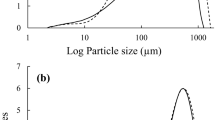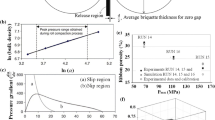Abstract
This paper focuses on the predictive model development for a pharmaceutically relevant model granulation process. A population balance modeling (PBM) framework has been employed for modeling purposes which is then utilized to obtain accurate predictions of the process. The model is aligned to adequately describe the high-shear mode of granulation operation in a batch process. The model is calibrated using the particle swarm algorithm (PSA) in the form of a multiobjective optimization problem. The multiobjective optimization problem was implemented based on the ε-constraint method which involves the handling of multiple cost functions in the form of constraints with the minimization of one primary objective function from the entire set of cost functions. The resultant solutions obtained from the model are Pareto optimal. The effects of the impeller speed, liquid-to-solid ratio, and wet massing time on the particle size distributions were characterized, and predicted size distributions were in agreement with experimental results. The predictive model framework lends itself to the quality by design (QbD) initiative undertaken by the US Food and Drug Administration (US FDA).







Similar content being viewed by others
References
Barrasso D, Ramachandran R. A comparison of model order reduction techniques for a four-dimensional population balance model describing multi-component wet granulation processes. Chem Eng Sci. 2012;80:380–92.
Barrasso D, Walia S, Ramachandran R. Multi-component population balance modeling of continuous granulation processes: a parametric study and comparison with experimental trends. Powder Technol. 2013;241:85–97.
Boukouvala F, Chaudhury A, Sen M, Zhou R, Mioduszewski L, Ierapetritou M, Ramachandran R. Computer-aided flowsheet simulation of a continuous tablet manufacturing process incorporating wet granulation. J Pharm Innov. 2013;8(1):11–27.
Braumann A, Kraft M, Wagner W. Numerical study of a stochastic particle algorithm solving a multidimensional population balance model for high shear granulation. J Comput Phys. 2010;229:7672–91.
Chaudhury A, Kapadia A, Prakash AV, Barrasso D, Ramachandran R. An extended cell-average technique for a multi-dimensional population balance of granulation describing aggregation and breakage. Adv Powder Technol. 2013a;24(6):962–71.
Chaudhury A, Niziolek A, Ramachandran R. Multi-dimensional mechanistic modeling of fluid bed granulation processes: an integrated approach. Adv Powder Technol. 2013b;24(1):113–31.
Chaudhury A, Ramachandran R. Integrated population balance model development and validation of a granulation process. Part Sci Technol. 2013;31(4):407–18.
Chaudhury A, Wu H, Khan M, Ramachandran R. A mechanistic population balance model for granulation processes: effect of process and formulation parameters. Chem Eng Sci. 2014;107:76–92.
Christofides PD. Control of nonlinear distributed process systems: recent developments and challenges. AIChE J. 2001;47(3):514–8.
FDA. 2004. Guidance for industry. pat-a framework for innovative pharmaceutical development, manufacturing, and quality assurance. http://www.fda.giv/cder/guidance/6419fnl.pdf. accessed on 30 May 2013.
Gantt JA, Gatzke EP. A stochastic technique for multidimensional granulation modeling. AIChE J. 2006;52(9):3067–77.
Gernaey KV, Gani R. A model-based systems approach to pharmaceutical product-process design and analysis. Chem Eng Sci. 2010;65(21):5757–69.
Giry K, Genty M, Viana M, Wuthrich P, Chulia D. Multiphase versus single pot granulation process: influence of process and granulation parameters on granules properties. Drug Dev Ind Pharm. 2006;32(5):509–30.
Hapgood KP, Litster JD, Smith R. Nucleation regime map for liquid bound granules. AIChE J. 2003;49(2):350–61.
Immanuel CD, Doyle FJ III. Computationally efficient solution of population balance models incorporating nucleation, growth and coagulation: application to emulsion polymerization. Chem Eng Sci. 2003;58(16):3681–98.
Immanuel CD, Doyle FJ III. Solution technique for a multi-dimensional population balance model describing granulation processes. Powder Technol. 2005;156(2–3):213–25.
Iveson S, Litster J. Fundamental studies of granule consolidation part 2: quantifying the effects of particle and binder properties. Powder Technol. 1998a;99(3):243–50.
Iveson SM, Litster JD. Growth regime map for liquid-bound granules. AIChE J. 1998b;44(7):1510–18.
Iveson SM, Litster JD, Hapgood K, Ennis BJ. Nucleation, growth and breakage phenomena in agitated wet granulation processes: a review. Powder Technol. 2001;117(1–2):3–39.
Kayrak-Talay D, Litster JD. A priori performance prediction in pharmaceutical wet granulation: testing the applicability of the nucleation regime map to a formulation with a broad size distribution and dry binder addition. Int J Pharm. 2011;418(2):254–64.
Kennedy J, Eberhart R. Particle swarm optimization. In: Proceedings of the IEEE international conference on neural networks, 1995. Proceedings. vol 4. 1995 p. 1942–1948.
Klatt KU, Marquardt W. Perspectives of process systems engineering-personal views from academia and industry. Comput Chem Eng. 2009;33:536–50.
Knight P, Instone T, Pearson JM, Hounslow M. An investigation into the kinetics of granulation using a high shear mixer. Powder Technol. 1993;77:159–69.
Kristensen HG. Particle agglomeration in high shear mixers. Powder Technol. 1996;88(3):197–202.
Li L, Yu X, Li X, Guo W. 2009. A modified pso algorithm for constrained multi-objective optimization. In: Third international conference on network and system security, 2009. NSS ’09. p. 462–467.
Linninger AA, Chowdhry S, Bahl V, Krendl H, Pinger H. A systems approach to mathematical modeling of industrial processes. Comput Chem Eng. 2000;24:591–8.
Madec L, Falk L, Plasari E. Modelling of the agglomeration in suspension process with multidimensional kernels. Powder Technol. 2003;130(1–3):147–53.
Pandey P, Tao J, Chaudhury A, Ramachandran R, Gao JZ, Bindra DS. A combined experimental and modeling approach to study the effects of high-shear wet granulation process parameters on granule characteristics. Pharm Dev Technol. 2013;18(1):210–24.
Pandey P, Tao J, Gao JZ, Bindra D, Narang A, Ramachandran R, Chaudhury A. 2011. A combined experimental and computational approach to the scale-up of high-shear wet granulation. In: Proc. 2011 AIChE annual meeting (Minneapolis, USA, October 2011).
Ramachandran R, Barton PI. Effective parameter estimation within a multi-dimensional population balance model framework. Chem Eng Sci. 2010;65(16):4884–93.
Ramachandran R, Poon JMH, Sanders CFW, Glaser T, Immanuel CD, Doyle FJ III, Litster JD, Stepanek F, Wang FY, Cameron IT. Experimental studies on distributions on granule size, binder content and porosity in batch drum granulation: inferences on process modelling requirements and process sensitivities. Powder Technol. 2008;188:89–101.
Salman AD, Hounslow MJ, Seville JPK. Granulation. Oxford: Elsevier; 2007.
Shi Y, Eberhart R. A modified particle swarm optimizer. In: Evolutionary computation proceedings, 1998. IEEE world congress on computational intelligence. (1998) p. 69–73.
Soos M, Sefcik J, Morbidelli M. Investigation of aggregation, breakage and restructuring kinetics of colloidal dispersions in turbulent flows by population balance modeling and static light scattering. Chem Eng Sci. 2006;61(8):2349–63.
Stepanek F, Rajniak P. Droplet morphologies on particles with macroscopic surface roughness. Langmuir. 2006;22(3):917–23.
Verkoeijen D, Pouw GA, Meesters GMH, Scarlett B. Population balances for particulate processes—a volume approach. Chem Eng Sci. 2002;57(12):2287–303.
žižek K, Hraste M, Gomzi Z. High shear granulation of dolomite—I: effect of shear regime on process kinetics. Chem Eng Res Des. 2013;91(1):70–86.
Acknowledgments
We are grateful to the National Institute for Pharmaceutical Technology and Education (NIPTE) and the US Food and Drug Administration (FDA) for providing funds for this research. This study was funded by the FDA-sponsored Grant “Critical Path Manufacturing Sector Research Initiative (5U01FD004275-02).” This work was also supported by the National Science Foundation Engineering Research Center on Structured Organic Particulate Systems, via Grant NSF-ECC 0540855. The authors also thank Dilbir Bindra and Jing Tao from Bristol-Myers Squibb for their contributions to this work. The support from various FDA managers including Dr. Mansoor Khan, Dr. Richard Lostritto, Dr. Vincent Vilker, and Mr. Jon E. Clark, and insightful FDA internal review by Dr. Cindy Buhse are acknowledged.
Disclaimer
The views and opinions expressed in this work are only of the authors and do not necessarily reflect the policy or statement of the US FDA.
Author information
Authors and Affiliations
Corresponding author
Rights and permissions
About this article
Cite this article
Chaudhury, A., Barrasso, D., Pandey, P. et al. Population Balance Model Development, Validation, and Prediction of CQAs of a High-Shear Wet Granulation Process: Towards QbD in Drug Product Pharmaceutical Manufacturing. J Pharm Innov 9, 53–64 (2014). https://doi.org/10.1007/s12247-014-9172-7
Published:
Issue Date:
DOI: https://doi.org/10.1007/s12247-014-9172-7




